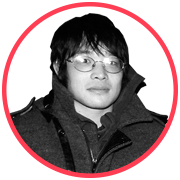Samurai Corner: Ikuru Kuwajima’s Central Asia

I was in a journalism school in Missouri, dreaming to become a reporter, but realized that my English is not that good to compete in the U.S. market and get a job there, so I tried photo and have been doing it ever since. My photojournalism background gave me confidence – I can walk up to someone I don’t know and ask them to get photographed.
After I moved to post-Soviet states my life gained intensity. There are so many stories to tell, and I’ve met so many interesting people that I don’t know if I could distinguish just one, but it comes to my mind that my Japanese liver was so weak that many a time I got to regret partying with someone on the next day of a classic drinking session, which is a good example of a stereotype having some truth in it, – that’s the reality I think of off the top of my head.
{
“img”: “/wp-content/uploads/2014/08/ikuru_trails_011.jpg”,
“alt”: “Project Trails 1”,
“text”: “Project Trails”
},
{
“img”: “/wp-content/uploads/2014/08/ikuru_trails_021.jpg”,
“alt”: “Project Trails 2”,
“text”: “Project Trails”
},
{
“img”: “/wp-content/uploads/2014/08/ikuru_trails_031.jpg”,
“alt”: “Project Trails 3”,
“text”: “Project Trails”
},
{
“img”: “/wp-content/uploads/2014/08/ikuru_trails_041.jpg”,
“alt”: “Project Trails 4”,
“text”: “Project Trails”
},
{
“img”: “/wp-content/uploads/2014/08/ikuru_trails_051.jpg”,
“alt”: “Project Trails 5”,
“text”: “Project Trails”
},
{
“img”: “/wp-content/uploads/2014/08/ikuru_trails_061.jpg”,
“alt”: “Project Trails 6”,
“text”: “Project Trails”
},
{
“img”: “/wp-content/uploads/2014/08/ikuru_trails_071.jpg”,
“alt”: “Project Trails 7”,
“text”: “Project Trails”
},
{
“img”: “/wp-content/uploads/2014/08/ikuru_trails_081.jpg”,
“alt”: “Project Trails 8”,
“text”: “Project Trails”
},
{
“img”: “/wp-content/uploads/2014/08/ikuru_trails_091.jpg”,
“alt”: “Project Trails 7”,
“text”: “Project Trails”
},
{
“img”: “/wp-content/uploads/2014/08/ikuru_trails_101.jpg”,
“alt”: “Project Trails 8”,
“text”: “Project Trails”
}
Project Trail is dedicated to Pamir – as a result of “The Great Game” (editor’s note: geopolitical rivalry between the Russian Empire and the British Empire for supremacy in Central Asia in 1813-1907) a new border was established which divided the mountain range in two parts.
While traveling in Tajikistan I just photographed what I saw, and put the photos together into one project. I wanted to convey the strange feeling that took over me when I was exploring the road, and how the border, which is artificial by default, changes the landscape and the whole perception of space.
In my project Astana I used diptychs (editor’s note – a work consisting of two panels) to show the inner and outer contrast of Kazakhstan’s capital city, which was quickly built up from the 90’s with help of the abundant oil money. But, I wasn’t so sure about efficiency of the diptych idea, so I think I also have non-diptych versions published somewhere.
{
“img”: “/wp-content/uploads/2014/08/ikuru_astana_01.jpg”,
“alt”: “Project Astana 1”,
“text”: “Project Astana”
},
{
“img”: “/wp-content/uploads/2014/08/ikuru_astana_02.jpg”,
“alt”: “Project Astana 2”,
“text”: “Project Astana”
},
{
“img”: “/wp-content/uploads/2014/08/ikuru_astana_041.jpg”,
“alt”: “Project Astana 3”,
“text”: “Project Astana”
},{
“img”: “/wp-content/uploads/2014/08/ikuru_astana_061.jpg”,
“alt”: “Project Astana 4”,
“text”: “Project Astana”
},
{
“img”: “/wp-content/uploads/2014/08/ikuru_astana_071.jpg”,
“alt”: “Project Astana 5”,
“text”: “Project Astana”
},
{
“img”: “/wp-content/uploads/2014/08/ikuru_astana_081.jpg”,
“alt”: “Project Astana 6”,
“text”: “Project Astana”
},
{
“img”: “/wp-content/uploads/2014/08/ikuru_astana_091.jpg”,
“alt”: “Project Astana 7”,
“text”: “Project Astana”
},
{
“img”: “/wp-content/uploads/2014/08/ikuru_astana_101.jpg”,
“alt”: “Project Astana 8”,
“text”: “Project Astana”
}
I am interested in the post-USSR regions in terms of history, culture, literature and so on – the complexity of everything in the regions is quite fascinating. I speak and think in Russian now, with some Japanese accent. I love the Russian language, I share the mentality, I enjoy the lifestyle, and feel comfortable here overall. I have great respect to those local photographers who photographed earlier than 2000’s, during the times when things were difficult, and managed to leave the records of what was going on and express their feelings in various ways.
The two girls wearing masks against the snowy background – I took the shot last winter, it was an orchestrated portrait of the Mari people in the Mari El Republic of Russia. The image grew on me because it was made differently from how I normally do it. The second picture is of a girl by a lake (editor’s note – see cover photo), I took it fairly recently as well, during my travels in the south of Russia. The third favorite shot is one of a young man praying in the middle of a steppe, I brought it from Kazakhstan. To me, the image fully captures the surrealistic scene of Central Asia.
{
“img”: “/wp-content/uploads/2014/08/ikuru_favourites_02.jpg”,
“alt”: “Ikuru Kuwajima 1”
}
Every year I find myself caring less and less about awards and prizes. Participation in competitions is merely a way to put yourself out there. I’m ambivalent towards names and titles, and that is why I feel unconditionally independent doing my thing. Perhaps it’s one of the reasons why I haven’t yet reached that “big career” level.
I am still unsure whether photography is a career to me or simply an outlet for self-expression, a reflection of my vision of the world. If I fail at photography and have to do it only for money I’ll quit and get a job as an interpreter, because I like languages just as much as I like photography. My main goal is to never give up. As they say in Russia, hope is the last one to die.
{
“img”: “/wp-content/uploads/2014/08/ikuru_favourites_03.jpg”,
“alt”: “Ikuru Kuwajima 1”
}
New and best




